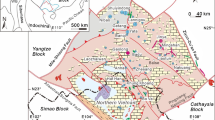Abstract
The Duolanasayi gold deposit, 60 km NW of Habahe County, Xinjiang Uygur Autonomous Region, is a mid-large-scale gold deposit controlled by brittle-ductile shearing, and superimposed by albitite veins and late-stage magma hydrothermal solutions. There are four types of pyrite, which are contained in the light metamorphosed rocks (limestone, siltstone), altered-mineralized rocks (chlorite-schist, altered albite-granite, mineralized phyllite), quartz veins and carbonatite veinlets. The pyrite is the most common ore mineral. The Au-barren pyrite is present mainly in a simple form and gold-bearing pyrite is present mainly in a composite form. From the top downwards, the pyrite varies in crystal form from {100} and {210}+{100} to {210}+{100}+{111} to {100}+{111}. Geochemical studies indicate that the molecular contents of pyrite range from Fe1.057S2 to Fe0.941S2. Gold positively correlates with Mn, Sr, Zn, Te, Pb, Ba and Ag. There are four groups of trace elements: Fe-Cu-Sr-Ag, Au-Te-Co, As-Pb-Zn and Mn-V-Ti-Ba-Ni-Cr in pyrite. The REE characteristics show that the total amount of REE (ΣREE) ranges from 32.35×10−6 to 132.18×10−6; LREE/HREE, 4.466–9.142; (La/Yb)N, 3.719–11.133; (Eu/Sm)N, 0.553–1.656; (Sm/Nd)N, 0.602–0.717; La/Yb, 6.26–18.75; δEu, 0.628–2.309; δCe, 0.308–0.816. Sulfur isotopic compositions (δ34S=−2.46‰–−7.02‰) suggest that the sulfur associated with gold mineralization was derived from the upper mantle or lower crust.
Similar content being viewed by others
References
Bohlke J. K., Coveney R. M., Jr Rye R. O. et al. (1988)Stable Isotope Investigations of Gold Quartz Veins at the Oriental Mine, Alleghang District, California [C]. pp. 279. Geological Survey Open File Report, U. S.
Chen Guangyuan, Shao Wei, and Sun Daisheng (1989)Genetic Mineralogy of Gold Deposit in Jiaodong Region with Emphasis of Gold Prospecting [M]. pp. 874. Chongqing Publishing House, Chongqing (in Chinese).
Chen Haoshou (1994)Isotopic Geochemistry [M]. pp. 339. Zhejiang University Publishing House, Hangzhou (in Chinese).
Chen Yuchuan, Ye Qingtong et al. (1996)Ore-forming Conditions and Metallogenic Prognosis of the Ashele Copper-Zinc Metallogenic Belt, Xinjiang [M]. pp. 5–32. Geological Publishing House, Beijing (in Chinese).
Gao Zhenmin, Yang Zhusen, Li Hongyang et al. (2000) Genesis and characteristics of gold hosted by pyrite [J].Geological Journal of China Universities (Nanjing).6, 156–162 (in Chinese with English abstract).
Li Huaqing, Xie Caifu, Chang Hailiang et al. (1998)Study on Metallogenetic Chronology of Nonferrous and Precious Metallic Ore Deposits in North Xinjiang, China [M]. pp. 264. Geological Publishing House, Beijing (in Chinese).
Liu Yingjun and Ma Dongsheng (1991)The Geochemistry of Gold [M]. pp. 400. Sciencs Press, Beijing (in Chinese).
Liu Yingjun, Cao Liming, Li Zhaolin et al. (1985)Elements Geochemistry [M]. pp. 548. Science Press, Beijing (in Chinese).
Rui Xingjian et al. (1993)Primary Gold Deposits in Altay, Xinjiang [M]. pp. 274. Geological Publishing House, Beijing (in Chinese).
Rui Xingjian et al. (1994)Treatises on Gold Deposits in Altay, Xinjiang [M]. pp. 6–78. Geological Publishing House, Beijing (in Chinese).
Seward T. M. (1973) The complexes of gold and the transport of gold in hydrothermal ore solutions [J].Geochimica et Cosmochimica Acta.37, 379–399.
Xiao Huiliang, Dong Yongguan, Zhou Jiyuan et al. (2002) Geological characteristic and brittle-ductile-magma coupled mineralization of Duolanasayi gold deposit, Xinjiang [J].Mineral Deposits.21 (sup.), 717–718 (in Chinese with English abstract).
Xiao Huiliang, Zhou Jiyuan, Wang Henian et al. (2003) Geochemical characteristics and source of ore-forming fluid of Duolanasayi gold deposit, Xinjiang [J].Chinese Journal of Geochemistry.22, 74–82.
Author information
Authors and Affiliations
Rights and permissions
About this article
Cite this article
Chen, G., Xiao, H., Wang, H. et al. Geochemical characteristics of pyrite in Duolanasayi gold deposit, Xinjiang. Chin. J. Geochem. 24, 280–288 (2005). https://doi.org/10.1007/BF02871323
Issue Date:
DOI: https://doi.org/10.1007/BF02871323



